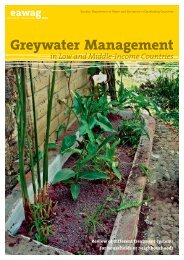Household Water Treatment and Safe Storage Factsheet: Source ...
Household Water Treatment and Safe Storage Factsheet: Source ...
Household Water Treatment and Safe Storage Factsheet: Source ...
You also want an ePaper? Increase the reach of your titles
YUMPU automatically turns print PDFs into web optimized ePapers that Google loves.
<strong>Household</strong> <strong>Water</strong> <strong>Treatment</strong> <strong>and</strong> <strong>Safe</strong> <strong>Storage</strong><br />
Fact Sheet: Solar Disinfection (SODIS) Key Data<br />
Inlet <strong>Water</strong> Criteria<br />
<br />
Turbidity < 30 NTU (Nephelometric Turbidity Units)<br />
<strong>Treatment</strong> Efficiency<br />
Laboratory<br />
Bacteria Viruses Protozoa Helminths Turbidity Chemicals<br />
99.9-<br />
99.99% 0 90-99.9%0 90-99.99% 3 > 100% 3 0% 0%<br />
Field 91.3-99.4% 0 Not available Not available Not available 0% 0%<br />
1 Wegelin et al (1994)<br />
2 Saladin (2002)<br />
3 Dependent on reaching a water temperature of 50°C<br />
<br />
SODIS can reduce the potential viability of Cryptosporidum parvum oocysts, although longer<br />
exposure periods appear to be required than those established for bacteria (Méndez-Hermida<br />
et al., 2007; Gómez-Couso et al., 2009). SODIS alone should not be expected to inactivate all<br />
Cryptosporidum parvum oocysts.<br />
Operating Criteria<br />
Flow Rate Batch Volume Daily <strong>Water</strong> Supply<br />
1-2 litres/bottle per<br />
6-48 hours<br />
1-2 litres/bottle Dependent on the number of bottles <strong>and</strong> weather<br />
<br />
<br />
<br />
<br />
<br />
<br />
<br />
Use a transparent, non-coloured plastic bottle made from polyethylene terephthalate (PET)<br />
Do not use plastic bottles made from polyvinyl chloride (PVC) since it contains additives that<br />
may leach into the water<br />
Some types of glass bottles (i.e. those with a higher content of iron oxide, like window glass)<br />
should not be used since they do not transmit as much UV-A light<br />
Bottles should be filled to ¾ of their capacity, capped <strong>and</strong> shaken for 20 seconds, <strong>and</strong> then<br />
filled to the top<br />
Requires 6 hours in full sun or up to 50% cloudy sky; or 2 consecutive days for more than<br />
50% cloudy sky<br />
Placing bottles on surfaces that reflect sunlight increases the treatment efficiency<br />
Treated water should be kept in the same bottle until it is consumed<br />
Robustness<br />
Bottle can be used as a safe storage container<br />
Requires suitable climate <strong>and</strong> weather conditions; most favourable location: between<br />
latitudes 15° <strong>and</strong> 35° north/south; next most favourable location: between latitudes 15°<br />
north/south <strong>and</strong> the equator<br />
PET bottles are abundant in urban areas, but may be less so in rural areas<br />
Not useful for treating large volumes of water, several bottles needed for a large family<br />
Bottles will soften <strong>and</strong> deform if the temperature reaches 65°C<br />
Users are unable to determine by their senses when sufficient disinfection has taken place,<br />
<strong>and</strong> so need to keep track of them to know which bottles have been treated <strong>and</strong> ensure that<br />
they always have treated water<br />
Estimated Lifespan<br />
<br />
Bottles become scratched or aged by sunlight <strong>and</strong> must be replaced periodically
















